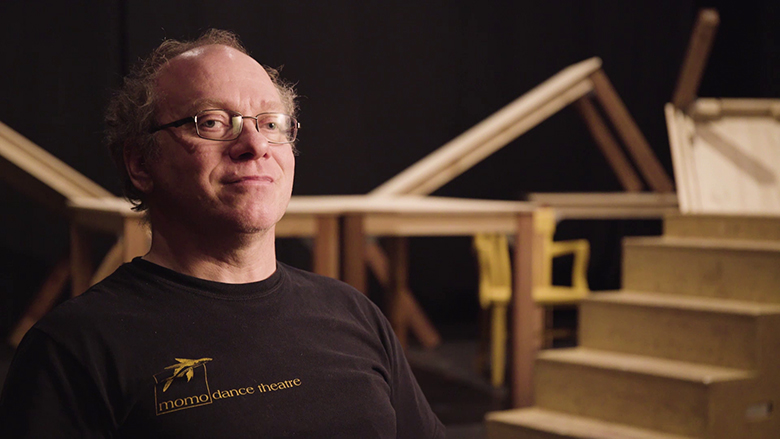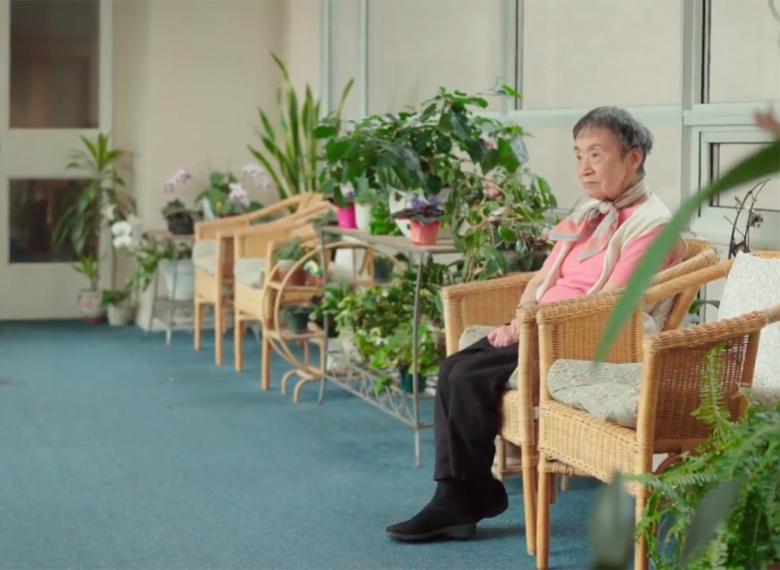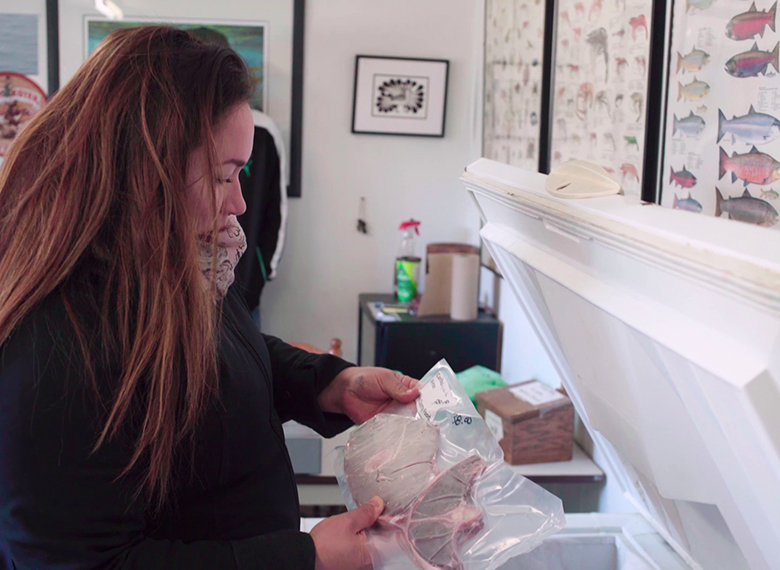The exhibit Our Canada, My Story opened in February 2017 and is one of four exhibitions showing this year at the Canadian Museum for Human Rights (CMHR) to recognize the 150th anniversary of Canada’s Confederation. Despite Canada’s reputation as a country that promotes and protects human rights at home and abroad, there are still many people and communities struggling to have their rights fully realized. Challenges range from food security in the north, to the rights of refugees and the resettlement process, to the present-day impacts of historical human rights violations. Locating human rights issues within personal experiences, Our Canada, My Story uses seven short films to explore the lives of seven Canadians from across the country. I spoke with Julia Peristerakis, lead curator for this exhibition, to discuss how the short films were conceptualized and developed, their diverse content, and how they explore human rights in Canada.
ALANA CONWAY: Our Canada, My Story focuses on seven short films to explore the lived experience of Canadians from across the country. Why did you choose these individuals, and how did you find them?
JULIA PERISTERAKIS: Humainologie, a multimedia production house from the Calgary Centre for Global Community, first approached us about collaborating on a project. They had just produced an exhibition using short films and personal storytelling to allow viewers to make a connection with someone, to better understand their experiences and develop empathy. We liked the concept and the power of film to create those important connections, so we decided to work with them to create a new set of films focusing on Canadian stories.
We began with selecting human rights themes that would work well for this type of personal storytelling and the sharing of lived experiences. We also wanted to explore some of the current human rights struggles that people are facing in Canada and what are they doing when they encounter those obstacles. Once we selected the themes, we searched for both French and English speaking people in different regions in Canada. We wanted to have diversity within the group of people, and we wanted this exhibition to have national reach. We then connected with different organizations that work in areas related to our chosen themes, used our own personal networks, and even looked up interesting stories in recent news articles to select our contributors.
Whether the topic is food security in the north, the rights of persons with disabilities, or the intergenerational impacts of human rights violations in Canada, we tried to balance how we illustrate the obstacles some Canadians are facing, while honouring their agency and the progress that has been made.
We traveled around the country to create these films, from Halifax to Vancouver, Iqaluit, Regina, Montreal and Calgary. Our contributor from Calgary was Thomas Poulsen, an advocate for disability rights and member of a mixed ability dance theatre. Thomas gave us the most feedback on his film, which we integrated because he really knew how he wanted his story to be told, and how he wanted the concerns of his community represented. I am grateful that we had the opportunity to share an early version of the film with him—he sadly passed away in January of this year, before the exhibition opened. However, his story will still be able to impact people through this film and this exhibition.
AC: Do any of the stories here offer a challenge or corrective to common myths about Canadian history and identity?
JP: While the stories in these films are hopeful and inspiring in their tone, they also show how much more work there is to be done. Whether the topic is food security in the north, the rights of persons with disabilities, or the intergenerational impacts of human rights violations in Canada, we tried to balance how we illustrate the obstacles some Canadians are facing, while honouring their agency and the progress that has been made. These films and stories also provide viewers with an opportunity to understand what it might be like to face challenges that they might never have had to contend with before.
Importantly, these themes are all relatable in terms of the basic rights being sought—to be safe, to be healthy, to be treated equally, to be fully included in society, to freely express ourselves about issues, to seek redress and reconciliation for historical wrongs.
We also made efforts to not reduce any of the people featured in the films to just one or two aspects of their identities. These films purposely show a rich portrayal of their lives and do not reduce anyone to a certain label or provide only a one-dimensional picture. These films explore different aspects of each person’s life, work and families, looks at the different communities of which they’re a part, and different spaces where their human rights stories play out—whether it is a dance recital, a community freezer, or a local archive.
AC: Most museums focus on artifacts and material culture, whereas the CMHR tends to focus more on personal experience and storytelling. How do you see the potential of film and media to tell stories related to human rights?
JP: Throughout our exhibitions, different types of storytelling feature prominently. Film is such a great medium to tell stories and provide a window into someone’s life and experiences, struggles and accomplishments. While watching these films, we want visitors to feel like they’re really getting to know someone, meeting them, understanding them and their situation, and ultimately, developing empathy into their particular experiences. The human rights themes in the films are ones that we address elsewhere in the Museum in more didactic exhibits, but through these films, those themes are humanized, providing viewers with the opportunity to really feel like they are getting to know the person and understand what they are experiencing.
Film is such a great medium to tell stories and provide a window into someone’s life and experiences, struggles and accomplishments.
We use digital media in many ways throughout our core and temporary exhibitions, including film, interactive touch screens, and augmented and virtual reality. For this exhibition, we offer an in-gallery programming activity and a digital activity; after visitors watch the films, they have the opportunity to share their story, using an instant film camera and post-it note. Every two weeks, a new question or statement related to the human rights themes in the films is posted, and visitors share their own human rights experiences by answering the question or finishing the statement. The photo and note are then pinned to a circle surrounding the question. Through this activity, we are able to capture numerous Canadian human rights stories from visitors across Canada and abroad. Connected to this is also a digital version where visitors can instead use an iPod to take a photo and share their story in the caption. The iPod is connected to an Instagram account, which then feeds back to an iPad in-gallery and the Instagram profile, @Canada150photo.
We also have a mobile app that includes not only our accessibility features like descriptive audio, but additional information and interactive experiences. These offerings will be expanded to our website so that the Museum can continue to connect people with our content across the country.
AC: What were some of the technical challenges in developing this exhibit?
JP: The exhibition is comprised of seven intimate, circular spaces throughout the gallery, one for each film. Each space has comfortable and accessible seating, soft carpets, and translucent banners are used to separate the spaces so that they are still fairly open and connected to the others. We made each space as inviting as possible, understanding that visitors are often tired at this point in their journey through the galleries. For this reason, we kept the films to less than five minutes each and ensured that they were very intimate and engaging. A beautiful river of lights guides visitors through the film spaces and provides warmth and makes the space feel inviting. The bulbs themselves also represent the many other stories or ideas that have yet to be shared.
We originally envisioned all of the films playing on loop in-gallery at the same time. The idea of conversation and openness really appealed to us in the design and our desired visitor experience. However, when all of the films were playing at once in the gallery, the sound was overwhelming. Some voices were louder and deeper than others, and so certain films were taking over the space and competing with others. We made a last minute decision to create 60 second attract loops with minimal dialogue for each film, rather than have the films all playing continuously. Visitors now select their preferred language, French or English, to begin the film.
It would be disingenuous to have an exhibition for Canada’s 150th that was strictly celebratory and did not confront some of the very real human rights issues that Canadians have faced and continue to face.
The timeline was fairly condensed to create these films and a small crew traveled to each location for several days to interview and film the person featured. For some contributors, there were multiple locations needed to tell their story. For example, we filmed with Sylvia Cloutier, who has been living in Iqaluit for many years now, and she shares her experiences with the high cost of food as a single mother living in the north. She was born and raised in Kuujjuaq, Nunavik (Northern Quebec) and we decided to also accompany her to her hometown to discuss some of the food programs and traditional ways that she accesses country foods for her family.
AC: The CMHR is located in Winnipeg and as a national museum celebrates stories from across Canada and around the globe. How have you enabled people to engage with this exhibit even if they’re not able to physically visit the site?
JP: It is really important to us to ensure that we are engaging with people across Canada, and it is something we have been working towards in different ways. We will be making all of the films available online during the run of the exhibition, although not all at the same time. Since the exhibition opened, we have had two of the films available online and have been promoting them on social media. The online discussion that has followed has been surprising. Part of our mandate is to encourage reflection and dialogue, and one of the videos in particular—that shares the story of Ali Duale, a former refugee from Somalia—has generated a lot of discussion.While the majority of comments have been positive and supporting, some of them have been disrespectful. But the incredible thing to see is that for every offensive comment, we’ve seen thirty comments or more that refute and challenge the original negative post. People are using information from the films to challenge ignorant or inappropriate comments. Some of the conversations even turn to entirely different human rights topics that people are discussing and sharing information about. So, this has been very encouraging, in terms of gauging the effect that the films are having on the viewers and the respectful dialogue that can emerge from sharing these stories. In this way, this exhibition has the opportunity to encourage respectful dialogue about human rights issues between people from across Canada, which truly fulfills our mandate.
AC: The exhibit is tied to Canada’s sesquicentennial, a moment of proclaimed celebration. Does the exhibit try to balance this celebratory climate with the realities of Canada’s own human rights record?
JP: We really tried to strike that balance. It would be disingenuous to have an exhibition for Canada’s 150th that was strictly celebratory and did not confront some of the very real human rights issues that Canadians have faced and continue to face. We have a total of four major exhibitions opening this year for Canada’s 150th, and each one takes a different tone and approach. Currently, we have one exhibition from the Canadian Museum of History, 1867: Rebellion & Confederation, that examines some of the ideas and struggles around rights in Canada at the time of Confederation—including communities and groups who were left out of those discussions, such as women, Indigenous peoples and newcomers. Our Canada, My Story, is both backwards and forwards looking, but ultimately grounded in people sharing their stories in the present. They share their community and family histories, and hopes and plans for the future of Canada, but the focus is really on taking stock of where we are right now, what challenges people are still facing, and what more can be done. When the exhibition ends its run in the late fall, we plan to offer it to other institutions as a traveling exhibition. We are also exploring opportunities to enter the individual films in film festivals. Creating an exhibition that is centred around digital media allows us to reach audiences in new ways and connect with people across the country.
Our Canada, My Story will be open until the fall of 2017 at the Canadian Museum for Human Rights in Winnipeg, Manitoba. You can visit the exhibition website to watch some of the full-length films on a rotating basis: https://humanrights.ca/exhibit/our-canada-my-story
Julia Peristerakis is a Curator at the Canadian Museum for Human Rights in Winnipeg, Manitoba where her work focuses on activism and social change. Since joining the Museum in 2013, she has been involved in the development of multiple exhibitions and worked with various stakeholder and community groups. She holds a Master’s degree in Sociology from the University of Manitoba where her thesis examined connections between the Indian residential school system and past and present child welfare practices in Canada.
Alana Conway is an independent researcher residing in Calgary, Alberta. She completed a Masters of Anthropology at Carleton University in 2011, with a thesis focusing on Roma Refugee Claimants in Canada between 2008 – 2009. Her interests lie in how human rights themes play out in everyday life, oral histories of Canada’s many cultural communities, particularly refugee issues, labeling of the other and representation.






